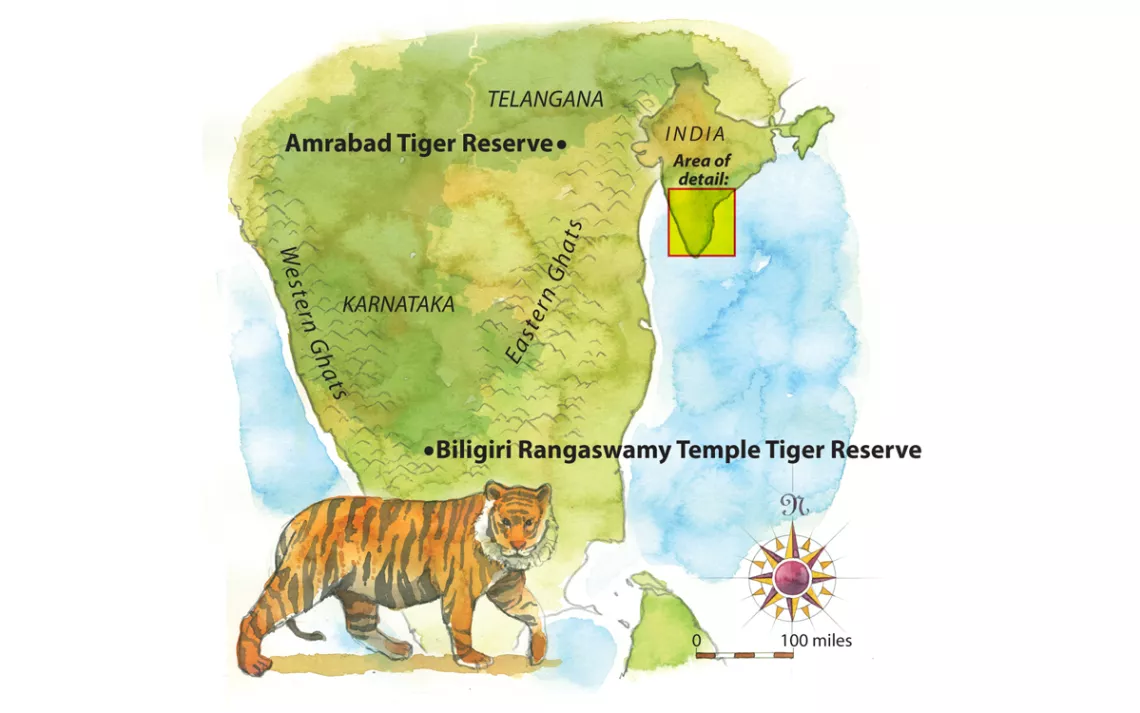Soligas and Tiger Conservation in BRT Tiger Reserve
The Soliga tribe inhabits the Biligiri Rangaswamy Temple (BRT) Tiger Reserve in Karnataka. Their relationship with the tiger population is very important to conservation efforts. Prime Minister Narendra Modi brought into light their contributions during the 119th edition of Mann Ki Baat. He noted a steady increase in tiger numbers, attributing much of this success to the Soligas. Their cultural reverence for tigers encourages harmony between humans and wildlife.
Soliga Tribe
- The name “Soliga” means “children of bamboo”.
- They live near Biligiri Rangana Hills and Male Mahadeshwara Hills.
- They were the first tribe in India to get official rights to live inside a tiger reserve (Biligiri Rangaswamy Temple Tiger Reserve).
- As of 2011, there were 33,871 Soligas in Karnataka and 5,965 in Tamil Nadu.
- They speak Sholaga (a Dravidian language), Kannada, and Tamil.
- Traditionally, they farm using shifting cultivation and collect forest products.
- Honey is an important food for them, and they gather many foods from the forest.
Soliga Cultural Practices
The Soligas worship tigers as sacred beings. They refer to the tiger as Dodda Nayi and maintain a temple dedicated to it. Their beliefs encourage conservation. The tribe’s lifestyle is simple and sustainable. This approach helps protect the wildlife habitat.
Human-Animal Conflict Mitigation
Human-animal conflict in the BRT Tiger Reserve is minimal. The Soligas’ deep understanding of animal behaviour plays important role. They know when to avoid certain areas. This knowledge reduces encounters with tigers. The tribe leaves a portion of their natural harvest for wildlife, promoting coexistence.
Role of the Forest Department
The Forest Department collaborates with the Soligas. Their local knowledge aids in various forest management activities. This includes fire protection efforts. The tribe’s involvement ensures effective conservation strategies.
Tiger Population Trends
The tiger population in the BRT Tiger Reserve has fluctuated. Reports from the National Tiger Conservation Authority (NTCA) show growth from 69 tigers in 2014 to 86 in 2018. However, the 2022 report indicated a decline. This decrease is linked to human interference and habitat degradation. Investigating these factors is essential for future conservation measures.
Importance of Tribal Rights
The Soligas were the first tribal community to have their forest rights recognised within a tiger reserve. This landmark court judgment in 2011 acknowledged their historical connection to the land. Recognising tribal rights is crucial for effective conservation. It empowers locals to participate actively in protecting their environment.
Broader Ecosystem Context
India’s ecosystems are rich and diverse. The coexistence of tribal communities and wildlife is a model for conservation. The Prime Minister cited examples from various states, denoting cultural practices that support biodiversity. The Huli Vesha dance of Karnataka showcases this connection.
Month: Current Affairs - February, 2025
Category: Environment Current Affairs






